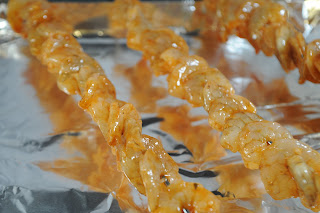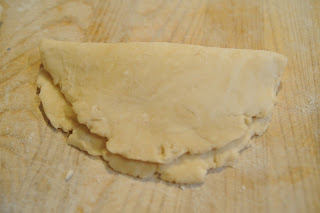| Recipes from Angola |
Fortunately, Angola was pretty easy on me, and the food both tasted and looked pretty good:
But first a little background. The Republic of Angola is a pretty good sized country in south central Africa. Here it is on the map:
From about the 16th century Angola was occupied to some extent by the Portuguese, who left their mark on the cuisine that is still popular there today. Angola has been independent since 1975, but it is a troubled place, with appallingly high rates of infant mortality, a very poor record of human rights and an average life expectancy for its citizens of less than 48 years.
Angolan cuisine depends greatly on imports from Portugal, as well as on non-western ingredients such as palm oil, banana leaves, cassava flour and a number of other things I couldn't find locally or even on igourmet.com. So I did have to pass up a number of otherwise perfectly good recipes just based on my failed pursuit of ingredients.
I also passed up many other recipes, including Cabidela, which is traditionally cooked in blood, Catatos, which is caterpillar fried in garlic (and I had a few juicy looking ones on my tomato plants this year too, darn it), Gafanhotos de palmeria (toasted grasshopper), Jinguinga (goat tripe and blood), and Mafuma, which is made out of frog's meat. I know, I know, they all sound delicious. What was I thinking.
Here are the dishes I did settle on:
Camarões Piri-Piri (Shrimp in red pepper sauce)
(from Recipes2Share)
- 2 pounds shrimp, peeled and deveined
- 1/2 cup Molho de Piri-Piri
- 6 cloves garlic, minced
Arroz de Coco e Papaia (Rice with coconut and papaya)
(from Celtnet)
- 1 cup rice
- 1/2 tsp salt
- 1/2 tsp ground cinnamon
- 2 cups coconut milk
- 1/4 cup water
- 1 papaya, peeled, de-seeded, and finely diced
Salada limão (Lemon salad)
(from Celtnet)
- 1/4 cup lemon juice
- 4 tsp olive oil
- 1/2 tsp salt
- 2 fennel bulbs
- 2 ounces finely grated parmesan cheese
Read more at Celtnet: http://www.celtnet.org.uk/recipes/miscellaneous/fetch-recipe.php?rid=misc-lemon-salad
Copyright © celtnet
Read more at Celtnet: http://www.celtnet.org.uk/recipes/miscellaneous/fetch-recipe.php?rid=misc-lemon-salad
Copyright © celtnet
Read more at Celtnet: http://www.celtnet.org.uk/recipes/miscellaneous/fetch-recipe.php?rid=misc-lemon-salad
Copyright © celtnet
Read more at Celtnet: http://www.celtnet.org.uk/recipes/miscellaneous/fetch-recipe.php?rid=misc-lemon-salad
Copyright © celtn1/4 cup lemon juice
You are, of course, wondering how to make "Molho de Piri-Piri," which is the key ingredient in Camarões Piri-Piri. Here's the recipe:
- Go to www.igourmet.com
- Search for "peri-peri" (an alternate spelling of the same thing)
- Click "Add to Cart"
- Check out
Is the a cop out? Not really. Well, kind of. Piri-piri is the Portuguese spelling for the African bird's eye chili pepper, which is native to Southern Africa. Now you can, with some effort, get piri-piri seeds and grow them here in the US, but I thought my chances of doing that in less than a week weren't very good, so that's not a route I chose. You can also buy pickled piri-piri peppers, but I thought that would change the flavor too much. A third alternative is to substitute habanero peppers, but that didn't seem particularly authentic either. So I chose to buy the ready-made sauce in the hope that it would provide for a finished product that was a little closer to what they might eat in Angola. Of course, I was disappointed to find that the peri-peri sauce sent to me by igourmet.com is actually bottled in Georgia, but I guess you can't have it all.
 |
| DiChickO's "Peri-Peri" sauce |
In case you'd rather make your own psuedo-piri-piri, here is the recipe:
- 3 to 5 habanero peppers
- 2 cloves of garlic
- 2 tsp salt
- 1/3 cup red wine vinegar
- 1 cup olive oil
Put the first four ingredients into a blender or food processor and pulse until smooth. With the blender running, slowly add the olive oil. Add salt to taste.
Now peel and devein your shrimp. I'm sure you love deveining as much as I do. Then add the piri-piri sauce and the crushed garlic to the shrimp. Mix well and refrigerate for at least 30 minutes.
 |
| The shrimp, peeled, deveined and marinading. Oh how I love deveining shrimp. |
Now on to the rice. I've made Jamaican peas and rice plenty of times, but have always had a hard time getting the rice to absorb the coconut milk, so lately I've been boiling the rice and then just adding it to the milk after the fact. This recipe gave me that "aha" moment (or maybe it was a "duh" moment) by instructing me to thin the coconut milk with 1/4 cup of water. Oh wow, that seems so obvious.
Now add the rice, salt and cinnamon.
 |
| Coconut milk, water and cinnamon |
Bring to a boil, then cover and reduce heat. Simmer for 20 minutes or until the rice is done (mine took quite a bit longer). Also it says to "fluff" the rice and let stand covered for 10 minutes. Mine was distinctly unfluffy. In fact, it was almost the opposite of fluffy, kind of risotto-like.
While you're doing all this, you can get the shrimp ready for grilling. Traditionally this dish would be cooked over an open flame, but in our house Martin does all the outdoor grilling. I usually broil anything that would otherwise be grilled.
Thread the shrimp onto skewers and cook for about five minutes, turning once, until the shrimp is pink (note this can be a little hard to figure with this recipe, since the marinade is red. You can also tell shrimp is done when it starts to curl and develop a firm texture).
 |
| The shrimp are skewered and ready for the broiler. |
Back to the rice: while the rice is standing (presumably undergoing fluffification, if you did it right), cut and seed the papaya, then finely dice it. Mash half of the dice and keep the other half as-is.
 |
| Dice half the papaya and mash the other half. |
Put both the mashed papaya and the diced papaya into the rice and mix, warming over the stove. Easy huh?
 |
| My finished rice looked a bit like risotto with papaya. |
Finally the salad, which was my least favorite part of the meal. Normally I like fennel as a garnish or as a minor ingredient, but as the focus of a salad it was a little overwhelming. Easy, though. Here's the directions:
Trim the fennel bulbs, reserving about two tablespoons of the fronds. Finely chop the fronds and whisk them together with the first three ingredients.
 |
| Lemon juice with fennel fronds, salt and olive oil. |
Thinly slice the fennel bulbs and toss with the dressing. Sprinkle with parmesan cheese and serve.
 |
| The finished salad was OK. A little too fennely for me. |
Now I didn't make my kids eat any of this, mainly because it was really spicy, and also because it was shrimp (I have a hard time even getting my husband to eat shrimp). Martin did give the meal kudos though, which is nice from a guy who doesn't like shrimp. "If I have to eat shrimp," he said, "This is probably one of the better ways to have it." So that's a high compliment. Sort of. He did also go back for seconds of the rice, though by popular vote the leftover salad went in the trash. Shame about all that wasted parmesan cheese.
Next week: Anguilla

































